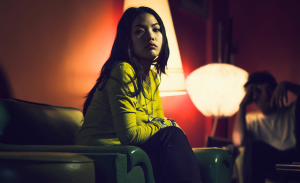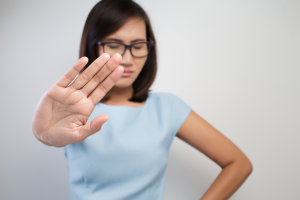Recently, a friend and I were talking about growing up Asian American in predominantly white neighborhoods and schools, and she told me that when she was in fifth grade, boys teased her on the playground by saying that she had a “sideways vagina.”
This has happened to me, too – and I’m sure to so many other Asian girls.
From racist humor in mid-1800s brothels to today’s playground jokes, the race and gender identity of Asian women is seen as so foreign, so “alien,” that our vaginas magically defy biology.
Throughout my life, I’ve received unwanted comments and questions about my body, specifically my anatomy, including being harassed on the street with calls like, “Ni hao,” “Konichiwa,” “Are you Chinese, Japanese, or Korean,” and recently, “Hi Ling Ling.”
On top of that, in my dating history, I was expected to be more quiet and less assertive.
The hyper-sexualization and fetishization of East Asian women is problematic – I am not “lucky” that my race and gender is imagined as sexy and exotic, that Asian women “all so beautiful.”
Or that, an image search of “Asian women” pulls up excessive pictures of women posing in lingerie.
Racial fetishes are about objectification, fetishizing an entire group of people – in this case Asian women, means reducing them down to stereotypes instead of recognizing their full personhood.
Beyond just personal preferences or “having a type,” racial fetishes project desired personality and behavior onto an entire racial or ethnic group.
The fetishization of Asian women even has a name, “yellow fever” – as if the obsession with Asian women were also a disease.
When my identity as an “Asian woman” becomes the only thing that’s important to someone in an interaction, that’s a problem.
This is different from an interracial partnership where all partners are equally respected. Fetishizing someone’s race and gender means not caring about someone as an individual.
So, where did the fetishization and objectification come from? How did Asian women get the hypersexualized stereotypes of being docile and submissive or being dangerous and seductive?
While today, some people might think of fetishes and sexual stereotypes as “not a big deal,” the history behind these tropes is rooted in violence and war, which get oppressively reimagined by mainstream media and entertainment.
Below are five ways East Asian women became fetishized and how that fetishization horribly impacts our lives.
1. Mainstream Media Creates the Submissive ‘Lotus Blossom’ and Evil ‘Dragon Lady’ Stereotypes
“[S]mall, weak, submissive and erotically alluring…She’s fun, you see, and so uncomplicated. She doesn’t go to assertiveness-training classes, insist on being treated like a person, fret about career moves…” —Tony Rivers, “Oriental Girls”, Gentleman’s Quarterly, 1990
Growing up, Lucy Liu was one of the only East Asian women I saw on TV and in movies. It was her, the Yellow Power Ranger (Thuy Trang), and Mulan.
For me, Liu is badass – both for being one of the only Asian American actresses in mainstream Hollywood and also for playing roles that literally kick ass.
However, many of her roles throughout the 90s and early 2000s, such as Ling Woo on Ally McBeal or as O-Ren Ishii in Kill Bill, were also ones that showed Asian women as beautifully evil, aggressive, and also mysterious.
Asian women are often stereotyped as either the dangerously cunning “Dragon Lady” that seduces White men, leading to their inevitable downfall, or as the submissive “Lotus Blossom.”
Both are meant to be demeaning and demonizing.
While there are exceptions, for the most part, mainstream media has created one dimensional, sexualized representations of Asian women that have affected the way they’re perceived by others.
Chinese actress Anna May Wong, the first Asian American actress to be internationally famous in the 1920s, was often cast in stereotypical supporting roles – and passed over for leading roles of Asian characters, which were given to white actresses in yellowface.
One of her most recognized characters was the demure, respectful Lotus Flower in The Toll of the Sea. The demure, subservient, and delicate “Lotus Blossom” stereotype is intended to cast Asian women as “less than,” both in terms of race and gender.
These stereotypes are seriously harmful. In the US, up to 61% of Asian women experience physical and/or sexual violence by an intimate partner during her lifetime.
Being docile is specifically about being deferent and obedient, especially to the authority of men.
As our race, gender, and sexuality become ruled by Western and male fantasy, in order to serve men sexually, Asian women must both be “feminine” and “heterosexual” and also either submissive and/or hypersexual.
These double stereotypes of “Lotus Blossom” and “Dragon Lady” reflect the ways that Asian women become transformed into either a sexual servant or embodied as a sexual adventure.
2. Labeling Products ‘Oriental’ Leads to the Objectification of East Asian Women as Exotic Commodities
Have you heard of Oriental rugs or Oriental lamps? What do those have in common? They’re objects.
“Oriental” was used as an adjective by “the West” to describe “the East.” And now, it’s often represented as anything with dragons, lotus blossoms, red lanterns, and other “mystical” symbols from the “Far East.”
The historical and media image and idea of “Oriental” also ends up lumping together all “Asian women” as East Asian and also conflates Chinese, Japanese, and Korean identities.
The “Orientalizing” of Asian women is a historical process where race, gender, class, immigration status, and also empire all play a role.
Since trade routes that opened up in the 1200s, notably the Silk Road, White adventurers sought to find exotic goods in the “Far East” – not only spices and fabrics, but women as well. (Netflix’s recent series Marco Polo retells this “White-guy-in-Asia” story.)
As seemingly faraway cultures and places begin being defined by objects and artifacts, these so-called exotic aesthetics end up getting imposed onto people and their physical appearance.
Similarly, Asian women become defined by their “jet black hair,” “dark almond eyes,” or “petite figure,” and that’s part of that objectification.
Like a porcelain vase, Asian women are often seen as decorative and fragile. Transformed into passive commodities of sex, our bodies must also be seen as weak and submissive – dainty, delicate, and small.
This shows up in everyday ways that men perceive sex with Asian women as something to collect. There’s a scene in Wedding Crashers where Vince Vaughn screams, “That was my first Asian!” Sadly, that line is used often in real life.
Like many other Asian women who have tried online dating, when I was on OKCupid, I received messages such as, “I’ve never been with an Asian before. Are you as exotic in bed as you look?” or “You’re a beautiful, delicate flower. Do you need someone to protect you?”
These expectations and demands on our external bodies also end up getting internalized – my identity as both Asian and a woman is constantly under scrutiny.
3. Exclusive Immigration Policies Create Perception of Asian Women as ‘Immoral’
Immigration policies affected the ways Asian women were perceived by White Americans.
Specific to the US, one example comes from Chinese American history. During the 1800s, most of Chinese people in the US were immigrant men working as low-cost laborers. The sexual interactions of Chinese immigrants were controlled by immigration laws and laws that prohibited interracial sexual relationships.
Many Chinese women who immigrated to the US around that time were women that were deceived and kidnapped or trafficked into serving this group of Chinese men.
Eventually, they also established White clientele, and racial stereotypes began to emerge that Chinese women were luring White men towards sin and expanded the trope of people in the sex industry as irresponsible and dangerous.
“Yellow Peril” anti-Chinese immigration sentiments also created the threatening perception of Asian women as “greedy, devious, and immoral.” The Page Act of 1875 prohibited “undesirable” immigrants from entering the US.
Other acts, like the “Gentlemen’s Agreement” discontinued passports for Japanese laborers to the US and Hawaii. However, it allowed women and children to join husbands, leading to over 10,000 Japanese and Korean women came to the US as arranged “picture brides.”
This practice was looked down upon by White Americans, adding to anti-Japanese sentiment at that time.
After World War II, Congress also passed the War Bride Act, where those serving abroad were allowed to bring Japanese and European wives home and Americans saw Japanese wives as virtuous homemakers.
Yet, while Asian men with picture brides were decidedly immoral, it was acceptable for White American soldiers to have war brides.
Today, the fantasy of having an overseas Asian wife continues through the “mail order bride” industry, which continues to both commercialize women and put them in vulnerable positions. In this industry, women can literally be “returned and exchanged.”
4. US Military Representations in Pop Culture Construct Asian Women as Subservient to White Men
“ The Problem of Miss Saigon makes us believe that we are worth less, that it is only through the white lover’s touch that we may be conferred a fuller humanity.” —Kai Cheng Thom
While the “East meets West” narrative is centuries overdone, literary and film history plays a role in the construction of Asian women as subservient.
In 1887, Pierre Loti wrote the novel Madame Chrysantheme about a French officer going to Japan to find a “dainty” and “delicate” woman “not much bigger than a doll.”
This becomes the main basis for Puccini’s 1904 opera Madame Butterfly. The gist is that an American soldier travels to Japan and takes on a Japanese wife.
He leaves her to return to legitimately marry a White American woman, and she ends up killing herself.
This storyline repeats itself in various films with settings across locations throughout Asia. Later, the 1989 musical Miss Saigon resets the narrative in Vietnam.
The problem with the Miss Saigon and Madame Butterfly storyline is that in these novels, plays, and films, Asian women from different places end up homogenized and literally depicted as ornamental objects created for the sole purpose of White men’s pleasure.
Later films and novels like The World of Suzie Wong embellished the Western soldier seeks Asian bride narrative by adding a savior element –Asian women needed to be rescued and protected by White men.
This narrative is something that I’ve internalized. I’ve found myself wondering in previous relationships and never truly being able to articulate out loud: Are you just trying to experience what it’s like being with an Asian woman? Are you just with me because I’m Asian?
As it turns out, these fictional tales and stories are also a big part of history.
5. War and Military Presence Produce Even More Sexual Violence
Throughout history, the sexual violence against women is used as a wartime weapon and women are seen as part of the “spoils of war.”
In World War II, Japan enslaved approximately 200,000 women across Asia, including Korea, China, Taiwan, Indonesia, and the Philippines to provide sex for its troops. Women were raped by multiple men every day.
After Japan surrendered to the United States, US occupation authorities approved of continuing the system for US troops, setting up a network of brothels under a “Recreation and Amusement Association.”
Military presence impacts local economies – for women who are poor, the sex industry offers an opportunity to make a living.
US military presence in Asia led to the creation of local sex industries and sex trafficking rings that would serve soldiers. Some of the first encounters soldiers ever had with Asian women were around the idea that these women were there to serve them sexually.
By the end of the Vietnam War, around 300,000 South Vietnamese women were working within the sex industry.
Although many women suffer horrible working conditions including assault and violence, institutions are more interested in turning women into commodities to serve military clientele then in the wellbeing of the women.
Also, thanks to Stanley Kubrick’s Full Metal Jacket, the experiences of these woman have been reduced down to one line: “Me so horny. Me love you long time.” Strangers will ask me on the street or in bars, “Will you love me long time?”
This historical violence carries on its legacy today in large scale ways. Human trafficking of domestic and sex workers continues to exploit women as commodities.
Over 30,000 Asian women are trafficked into the US each year.
Wars against Japan, Korea, the Philippines, and Vietnam have also created national imagery that gets represented in pop culture and then get internalized by any Americans who may not know any Asians or Asian Americans.
Asian nations and the people from them are perceived as both dangerous as well as desired objects of conquest.
***
The objectification and fetishization of Asian women comes out of devastating wars and exclusionary immigration practices that get re-transcribed by books, movies, and other mass-consumed media.
While some folks might think that these sexual stereotypes are a “compliment” or “positive,” the ongoing violence perpetrated against Asian women as a direct result of these stereotypes get overlooked.
Objectification is about being seen as less than human. As unworthy of anything else but a singular use and function.
Asian and Asian American women continue to be objectified sexually through cultural consumption and misrepresentation in ways that also have negative day-to-day impacts, from commuting to dating.
[do_widget id=’text-101′]
Rachel Kuo is a Contributing Writer for Everyday Feminism and a scholar and educator based in New York City. Her professional background is in designing curriculum and also communications strategy for social justice education initiatives. You can follow her on Twitter @rachelkuo.
Search our 3000+ articles!
Read our articles about:
Our online racial justice training
Used by hundreds of universities, non-profits, and businesses.
Click to learn more





















